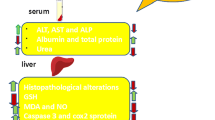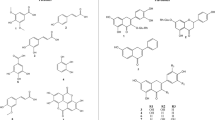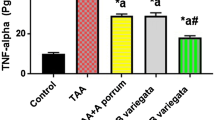Abstract
Cassia fistula L. (Caesalpinioideae) is a highly admirable medicinal plant and is traditionally recommended for the treatment of rheumatism, liver disorders, jaundice, and other inflammatory diseases. This study was designed to investigate the hepatoprotective properties of ethyl acetate fraction from C. fistula leaves in an animal model. Treatment with thioacetamide significantly elevated the level of serum glutamic-oxaloacetic transaminase (1.75-fold), alkaline phosphatase (4.07-fold), and total bilirubin (2.29-fold) as compared to the control. It was found that pretreatment of fraction followed by consecutive 2 days thioacetamide reduced the conversion of thioacetamide carcinogen to its reactive metabolites by phase I enzymes and increased the level of detoxification phase II along with antioxidative enzymes. The histopathological studies revealed the hepatoprotective nature of the fraction in restoring the normal architecture of thioacetamide-intoxicated damaged liver. The fraction showed downregulation in the expression level of p-PI3K, p-Akt, and p-mTOR pointing towards its chemopreventive potential. The HPLC analysis of the fraction had shown the dominance of three phenolic compounds namely, catechin, epicatechin, and chlorogenic acid. The above studies comprising histopathological, immunohistochemical, and hepatic enzymes are strong indicative of the potential protective ability of ethyl acetate fraction phytoconstituents against thioacetamide-induced toxicity.

Graphical abstract






Similar content being viewed by others
Data availability
All the data generated and analyzed are included in this article.
Abbreviations
- ROS:
-
reactive oxygen species
- RNS:
-
reactive nitrogen species
- HPLC:
-
high-performance liquid chromatography
- MDA:
-
malondialdehyde
- CYP:
-
cytochrome P450
- TAA:
-
thioacetamide
- p-PI3:
-
phosphorylated-phosphatidylinositol-3-kinase
- p-Akt:
-
phosphorylated-Akt
- p-mTOR:
-
phosphorylated-mammalian target of rapamycin
- GSSG:
-
oxidized glutathione
- GSH:
-
reduced glutathione
- bw:
-
bodyweight
- i.p:
-
intraperitoneal
- CPCSEA:
-
Committee for the Purpose of Control and Supervision of Experiments on Animals
- ANOVA:
-
analysis of variance
- MLR:
-
multiple linear regression
References
Abdeen A, Abdelkader A, Abdo M, Wareth G, Aboubakr M, Aleya L, Abdel-Daim MM (2019) Protective effect of cinnamon against acetaminophen-mediated cellular damage and apoptosis in renal tissue. Environ Sci Pollut Res 26:240–249
Abdel-Daim MM, Abdellatief SA (2018) Attenuating effects of caffeic acid phenethyl ester and betaine on abamectin-induced hepatotoxicity and nephrotoxicity. Environ Sci Pollut Res 25:15909–15917
Abdel-Daim MM, Abushouk AI, Reggi R, Yarla NS, Palmery M, Peluso I (2018a) Association of antioxidant nutraceuticals and acetaminophen (paracetamol): friend or foe? J Food Drug Anal 26:S78–S87
Abdel-Daim MM, Sooud KA-EL, Aleya L, Bungǎu SG, Najda A, Saluja R (2018b) Alleviation of Drugs and Chemicals Toxicity: Biomedical Value of Antioxidants. Oxidative Med Cell Longev:1–2. https://doi.org/10.1155/2018/6276438
Abdel-Daim MM, Zakhary N, Aleya L, Bungǎu SG, Bohara RA, Siddiqi NJ (2018c) Aging, Metabolic, and Degenerative Disorders: Biomedical Value of Antioxidants. Oxidative Med Cell Longev:1–2. https://doi.org/10.1155/2018/2098123
Abdel-Daim MM, Dessouki AA, Abdel-Rahman HG, Eltaysh R, Alkahtani S (2019) Hepatorenal protective effects of taurine and N-acetylcysteine against fipronil-induced injuries: the antioxidant status and apoptotic markers expression in rats. Sci Total Environ 650:2063–2073
Aebi H (1984) Catalase in vitro. In: Colowick, Kaplan SP (eds) Methods in enzymology, vol 105. Academic Press, New York, pp 121–126
Allocati N, Masulli M, Di Ilio C, Federici L (2018) Glutathione transferases: substrates, inihibitors and pro-drugs in cancer and neurodegenerative diseases. Oncogenesis 7(1):8. https://doi.org/10.1038/s41389-017-0025-3
Al-Sayed E, Abdel-Daim MM, Kilany OE, Karonen M, Sinkkonen J (2015) Protective role of polyphenols from Bauhinia hookeri against carbon tetrachloride-induced hepato- and nephrotoxicity in mice. Ren Fail 37(7):1198–1207
Al-Sayed E, Abdel-Daim MM, Khattab MA (2018) Hepatoprotective activity of praecoxin A isolated from Melaleuca ericifolia against carbon tetrachloride-induced hepatotoxicity in mice. Impact on oxidative stress, inflammation, and apoptosis. Phytother Res:1–10. https://doi.org/10.1002/ptr.6242
Anderson ME (1985) Determination of glutathione and glutathione disulfide in biological samples. In: Meister A (ed) Methods in enzymology, vol 113. Academic Press, NewYork, pp 548–551
Arora N, Bansal MP, Koul A (2013) Modulatory effects of Azadirachta indica leaf extract on cutaneous and hepatic biochemical status during promotion phase of DMBA/TPA-induced skin tumorigenesis in mice. Indian J Biochem Biophys 50(2):105–113
Baali N, Belloum Z, Baali S, Chabi B, Pessemesse L, Fouret G, Ameddah S, Benayache F, Benayache S, Feillet-Coudray C, Cabello G, Wrutniak-Cabello C (2016) Protective activity of total polyphenols from Genista quadriflora Munby and Teucrium polium geyrii Maire in acetaminophen-induced hepatotoxicity in rats. Nutrients 8(4):193. https://doi.org/10.3390/nu8040193
Bardi DA, Halabi MF, Hassandarvish P, Rouhollahi E, Paydar M, Moghadamtousi SZ, Al-Wajeeh NS, Ablat A, Abdullah NA, Abdulla MA (2014) Andrographis paniculata leaf extract prevents thioacetamide-induced liver cirrhosis in rats. PLoS One 9(10):e109424
Bashandy SAE, Ebaid H, Abdelmottaleb Moussa SA, Alhazza IM, Hassan I, Alaamer A, Tamimi J (2018) Potential effects of the combination of nicotinamide, vitamin B2 and vitamin C on oxidative-mediated hepatotoxicity induced by thioacetamide. Lipids Health Dis 17:29
Bhalerao SA, Kelkar TS (2012) Traditional medicinal uses, phytochemical profile and pharmacological activities of Cassia fistula Linn. Int Res J Biol 1(5):79–84
Carlberg I, Mannervik B (1975) Glutathione reductase. In: Meister A (ed) Methods in enzymology, vol 113. Academic Press, New York, pp 484–490
Chhabra G, Singh CK, Ndiaye MA, Fedorowicz S, Molot A, Ahmad N (2018) Prostate cancer chemoprevention by natural agents: clinical evidence and potential implications. Cancer Lett 422:9–18
Choi SJ, Kim M, Kim SH, Jeon JK (2003) Microplate assay measurement of cytochrome P450-carbon monoxide complexes. J Biochem Mol Biol 36(3):332–335
Devasagayam TPA, Boloor KK, Ramasarma T (2003) Methods for estimating lipid peroxidation: ananalysis of merits and demerits. Indian J Biochem Biophys 40:300–308
Fruman DA, Rommel C (2014) PI3K and cancer: lessons, challenges and opportunities. Nat Rev Drug Discov 13(2):140–156
Gan FF, Ling H, Ang XA (2013) Novel shogaol analog suppresses cancer cell invasion and inflammation, and displays cytoprotective effects through modulation of NF-κB and Nrf2-Keap1 signaling pathways. Toxicol Appl Pharmacol 272:852–862
Habig WH, Pabst MJ, Jakoby WB (1974) Glutathione S-transferase—the first enzymatic step in mercapturic acid formation. J Biol Chem 249(22):7130–7139
Hajovsky H, Hu G, Koen Y, Sarma D, Cui W, Moore DS, Staudinger JL, Hanzlik RP (2012) Metabolism and toxicity of thioacetamide and thioacetamide S-oxide in rat hepatocytes. Chem Res Toxicol 25:1955–1963
Hamada S, Ohyama W, Takashima R, Shimada K, Matsumoto K, Kawakami S, Uno F, Sui H, Shimada Y, Imamura T, Matsumura S, Sanada H, Inoue K, Muto S, Ogawa I, Hayashi A, Takayanagi T, Ogiwara Y, Maeda A, Okada E, Terashima Y, Takasawa H, Narumi K, Wako Y, Kawasako K, Sano M, Ohashi N, Morita T, Kojima H, Honma M, Hayashi M (2015) Evaluation of the repeated-dose liver and gastrointestinal tract micronucleus assays with 22 chemicals using young adult rats: summary of the collaborative study by the collaborative study group for the micronucleus test (CSGMT)/the Japanese Environmental Mutagen Society (JEMS) – Mammalian Mutagenicity Study Group (MMS). Mutat Res 780–781:2–17
Jiang ZY, Hunt JV, Wolff SP (1992) Ferrous ion oxidation in the presence of xylenol orange for detection of lipid hydroperoxides in low density lipoprotein. Anal Biochem 202:384–389
Kalantari H, Jalali M, Jalali A, Mahdavinia M, Salimi A, Juhasz B, Tosaki A, Gesztelyi R (2011) Protective effect of Cassia fistula fruit extract against bromobenzene-induced liver injury in mice. Hum Exp Toxicol 30(8):1039–1044
Kaur V, Kumar M, Kaur P, Kaur S, Singh AP, Kaur SJ (2017) Hepatoprotective activity of Butea monosperma bark against thioacetamide-induced liver injury in rats. Biomed Pharmacother 89:332–341
Koppula S, Yum M-J, Kim J-S, Shin G-M, Chae Y-J, Yoon T, Chun C-S, Lee J-D, Song MD (2017) Anti-fibrotic effects of Orostachys japonicus A. Berger (Crassulaceae) on hepatic stellate cells and thioacetamide-induced fibrosis in rats. Nutr Res Pract 11(6):470–478
Kristin R, Landis-Piwowar Iyer NR (2014) Cancer chemoprevention: Current State of the Art. Can Growth Metast 7:19–25
Lampe WJ, King BI, Li S, Grate TM, Barale VK, Chen C, Fenz Z, Potter DJ (2000) Brassica vegetables increase and apiaceous vegetables decrease cytochrome P4501A2 activity in humans: changes in caffeine metabolite. Ratios in response to controlled vegetable diets. Carcinogenesis 21:1157–1162
Li S, Hong M, Tan HY, Wang N, Feng YB (2016) Insights into the role and interdependence of oxidative stress and inflammation in liver diseases. Oxidative Med Cell Longev 2016:1–21. https://doi.org/10.1155/2016/4234061
Liu Y, Yin T, Feng Y, Cona MM, Huang G, Liu J, Song S, Jiang Y, Xia Q, Swinnen JV, Bormans G, Himmelreich U, Oyen R, Ni Y (2015) Mammalian models of chemically induced primary malignancies exploitable for imaging-based preclinical theragnostic research. Quant Imaging Med Surg 5(5):708–729
Mihara K, Sato R (1972) Partial purification of cytochrome b5 reductase from rabit liver microsome with detergent and its properties. J Biochem 71:725–735
Noorhajati H, Tanjung M, Aminah NS, Suwandi JS (2012) Antioxidant Activities of Extracts of Trengguli Stem Bark (Cassia fistula L.). IJBAS 12(4):85–89
Omura T, Sato R (1964) The carbon monoxide-binding pigment of liver micro-somes. J Biol Chem 239(7):2370–2378
Omura T, Takasue S (1970) A new method for simultaneous purification of cytochrome b5 and NADPH-cytochrome c reductase from rat liver micro-somes. J Biochem 67:249–257
Pallottini V, Martini C, Bassi AM, Romano P, Nanni G, Trentalance A (2006) Rat HMGCoA reductase activation in thioacetamide-induced liver injury is related to an increased reactive oxygen species content. J Hepatol 44(2):368–374
Petrovska BB (2012) Historical review of medicinal plants’ usage. Pharmacogn Rev 6(11):1–5
Poli GPM (1997) Oxidative damage and fibrogenesis. Free Radic Biol Med 22:287–305
Porta C, Paglino C, Mosca A (2014) Targeting PI3K/Akt/mTOR signaling in cancer. Front Oncol 64:1–11
Pradeep K, Mohan CV, Gobianand K, Karthikeyan S (2007) Effect of Cassia fistula Linn. leaf extract on diethylnitrosamine induced hepatic injury in rats. Chem Biol Interact 167(1):12–18
Quintanilha LF, Takami T, Hirose Y, Fujisawa K, Murata Y, Yamamoto N, dos RC, Goldenberg S, Terai S, Sakaida I (2014) Canine mesenchymal stem cells show antioxidant properties against thioacetamide-induced liver injury in vitro and in vivo. Hepatol Res 44:206–217
Sabir SM, Rocha JBT, Boligon AA, Athayde ML (2017) Hepatoprotective activity and phenolic profile of Zanthoxylum alatum Roxb. fruit extract. Pak J Pharm Sci 30(5):1551–1556
Shu L, Cheung K-L, Khor TO, Chen C, Kong A-N (2010) Phytochemicals: cancer chemoprevention and suppression of tumor onset and metastasis. Cancer Metastasis Rev 29:483–502
Smith PK, Krohn RI, Hermanson GT, Mallia AK, Gartner FH, Provenzano MD, Fujimoto EK, Goeke NM, Olson BJ, Klenk DC (1985) Measurement of protein using bicinchoninic acid. Anal Biochem 150:76–85.
Watson RR, Preedy V (2012) Bioactive food as dietary interventions for liver and gastrointestinal disease, 1st edn. Academic Press, Elsevier Inc., USA
Wu D, Zhai Q, Shi X (2006) Alcohol-induced oxidative stress and cell responses. J Gastroenterol Hepatol 21(3):S26–S29
Xie Y, Wang G, Wang H, Yao X, Jiang S, Kang A (2012) Cytochrome P450 dysregulations in thioacetamide-induced liver cirrhosis in rats and the counteracting effects of hepatoprotective agents. Drug Metab Dispos 40:796–802
Yeung AWK, Tzvetkov NT, El-Tawil OS, Bungǎu SG, Abdel-Daim MM, Atanasov AG (2019) Antioxidants: scientific literature landscape analysis. Oxidative Med Cell Longev 2019:1–12. https://doi.org/10.1155/2019/8278454
Acknowledgments
We would like to acknowledge Dr. (Prof.) Mridu Manjari, Department of Pathology (Sri Guru Ramdas Cancer hospital and University of Health Sciences, Amritsar) for performing histopathological studies and for immunohistochemical studies; Centre for Emerging Life Science for HPLC analysis and Mr. Manjinder Singh (Department of Pharmaceutical Sciences) for animal handling, Guru Nanak Dev University, Amritsar.
Funding
This study receives financial assistance provided by the Indian Council of Medical Research (ICMR) [59/36/2011/BMS/TRM] and the Fund for Improvement of S & T Infrastructure (FIST) programme of Department of Science and Technology (DST) [SR/S9/Z-23/2010/20(C)], New Delhi, India.
Author information
Authors and Affiliations
Contributions
Provided guidance, drafted the manuscript and revising it critically, and finalized it with her personal inputs: S.J.K. and A.P.S. Performed the experiments and reviewed the literature: S.K., A.P.S, and D.S. Statistical analysis of the results, interpretation of data: S.K., A.P.S, and D.S. Designed the table, figures, and images: S.K and S.J.K.
Corresponding author
Ethics declarations
Ethical approval and consent to participate
This study was approved by the Committee for the Purpose of Control and Supervision of Experiments on Animals (CPCSE), Government of India (226/CPCSEA/2014/06). All animals were humane care according to the criteria outlined in the guidelines of the Institutional Animal Ethics Committee (IAEC) and written informed consent was obtained.
Competing interests
The authors declare that they have no competing interests.
Additional information
Responsible editor: Philippe Garrigues
Publisher’s note
Springer Nature remains neutral with regard to jurisdictional claims in published maps and institutional affiliations.
Highlights
(1) CaLE fraction of C. fistula inhibited the TAA-induced alterations in the hepatic serum marker enzymes in male Wistar rats.
(2) TAA-induced cytochrome b5 activity was effectively inhibited by the CaLE fraction.
(3) IHC studies showed the potential of CaLE fraction in lowering the elevated expression level of p-PI3K, p-Akt, and p-mTOR in TAA-administrated Wistar rats.
4) HPLC analysis revealed the presence of catechin, epicatechin, and chlorogenic acid in appreciable amounts.
Rights and permissions
About this article
Cite this article
Kaur, S., Sharma, D., Singh, A.P. et al. Amelioration of hepatic function, oxidative stress, and histopathologic damages by Cassia fistula L. fraction in thioacetamide-induced liver toxicity. Environ Sci Pollut Res 26, 29930–29945 (2019). https://doi.org/10.1007/s11356-019-06158-y
Received:
Accepted:
Published:
Issue Date:
DOI: https://doi.org/10.1007/s11356-019-06158-y




